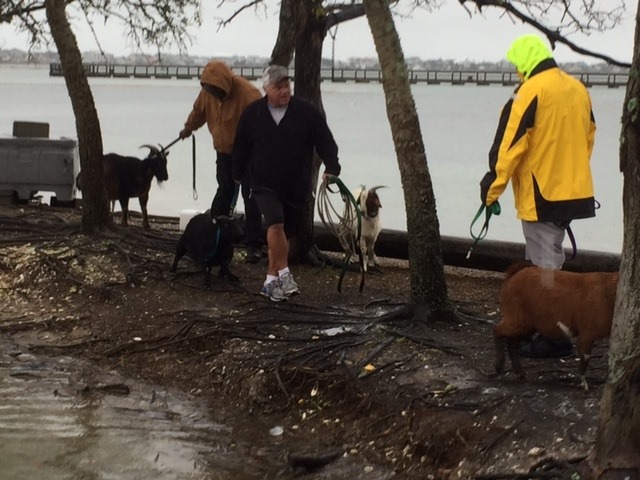
Goat Island Roundup signals end of summer vacation for dozen denizens

A goat enjoys a celery stalk on the Murrells Inlet Marshwalk after being removed from Goat Island for the winter.
Ever see a goat on a boat? With the possible exceptions of a Dr. Seuss book or an Army-Navy football rivalry prank, there’s only one place and one time of year to see it for yourself – the annual Goat Island Roundup in Murrells Inlet.
The traditional removal of the goats from the tiny island behind Drunken Jack’s Restaurant & Lounge has become one of the most popular events on the Murrells Inlet Marshwalk, at least when it isn’t cold, rainy and windy like this year’s roundup.
“We usually have 200 to 300 people lined up along the dock,” said Al Hitchcock, owner of Drunken Jack’s and commander of the annual goat-herding operation, “almost as many as we have for the (Murrells Inlet Fourth of July) Boat Parade.”
Coincidentally, the two rituals are celebrating their 36th anniversaries after making their maiden voyages in the mid-1980s. But unlike the well-scripted patriotic boat flotilla, the Goat Island Roundup is infinitely less predictable.
“After 36 years you start to figure it out,” Hitchcock said, “but it never goes exactly according to plan.”
Despite their good intentions of wrangling the goats to go to their warm winter home at nearby Osprey Marina, the wranglees seem to prefer island life and often won’t leave without a good chase. The result resembles a Benny Hill skit.
“We have been coming for the past five or six years,” said spectator Gene Ginther, who braved the weather with his wife, Jackie, under the cover of Drunken Jack’s back porch. “This is the best comedy show you can find on the Marshwalk.”

Bubba Love (left) and Al Hitchcock (right) help fellow wranglers round up goats for their annual removal.
Goat Busters
Before we get to the action, some of you may need some clarification, like, ‘Why are goats on an island?'” Good question: One that is incessantly asked by disbelieving visitors and tirelessly answered by locals during the summer months.
Like most legends in this historic fishing village, the story of Goat Island has a shady past. It was originally called Drunken Jack’s Island, named for a poor pirate who was abandoned there with nothing but bottles of rum for survival.
The birth of Goat Island had more to do with a different controlled substance. Contrary to tales of Spanish explorers stashing the goats for safe-keeping and pirates using them to mark buried treasure, Hitchcock sets the record straight:
“We had some teenage boys going over there with big water jugs,” he recalled. “I don’t know what they were up to but people thought they were growing marijuana. I didn’t want to mess with it so I said, ‘Let’s put some goats over there.'”
Why goats? Turns out they are nature’s original lawnmowers and weedeaters.
“They will eat anything green,” Hitchcock said.
So have the goats exhibited any signs of chewing on the wacky weed?
“I don’t know,” he smiled, “but they do eat a lot.”
Munchies not withstanding, this year’s roundup figured to be twice as difficult because there were twice as many goats – 12 instead of the usual six thanks to a visiting herd from New Hampshire (that’s another crazy story), but perhaps twice as easy thanks to the weather conditions.
“We like doing it in the rain because they hang out together under their shelter to stay dry,” Hitchcock explained. “At least that’s the plan.”

A wrangler attempts to catch a goat during the annual Goat Island Roundup in Murrells Inlet.
Getting Their Goats
So how do you round up a dozen goats on a strip of land about the size and shape of a short par 3 with lots of water hazards? In a word, experience.
“After 36 years (plus hurricane evacuations) you start to figure it out,” Hitchcock joked, “but it never goes exactly according to plan.”
Here’s what you need for a successful operation: A pontoon boat for ferrying the goats, a jon boat for transporting the wranglers, and a high tide for giving the goats as little room to run and hide as possible. It also requires a wooden gang plank, ropes, dog collars and leashes, lots of celery and carrots, and a few good friends who don’t mind getting wet and muddy to humanely catch the cute but surprisingly elusive critters.
This year’s crew featured the usual suspects, led by Bubba Love, the proud caretaker of the animals during their seven-month stay and a bit of a goat whisperer.
“Whenever they see Bubba, they know there’s food,” Hitchcock laughed.
Using Bubba as bait, the wranglers slowly cut off escape routes and herd the flock toward the boat, which is landed close enough to reach the island by gang plank. Wranglers gently try to leash them and coax them to get onboard with bribes of carrot sticks and celery stalks.
“If we can get the billy on the boat, the rest of them will follow, but this billy is trouble. We have to swap them out every few years to prevent too much inbreeding, and his time is up.”
As it turns out, goat-wrangling is a lot like chess: The key is capturing the king. In this case, the king is the billy goat, known simply as “The Man” for his domineering ways. Perhaps knowing his island time was up, The Man made it a long day for the men with ropes.

The billy goat (left) and his herd are bribed with carrots and celery to get onboard with the Goat Island Roundup.
Man vs. ‘The Man’
This year’s crew had one green horn – me. I grew up around goats in Tennessee, but these are island goats with home-field advantage. No biggie, my job was to stay on the boat and take photos, at least until the ropes started flying.
Things couldn’t have started better. Four goats came aboard with little fuss, almost like they knew their summer vacation was over and it was checkout time. Somehow I was handed their leashes, which made for some interesting pics as one attempted to eat my camera. We took the first load back to shore and walked them to the awaiting trailers while the others held out for more food.
I missed the boat back but had a front-row seat for the turning point. Strategically placed celery on the deck caused the capture of a few more, and the billy actually put his front hooves on the gang plank while the other awaited his cue. The Man was two steps from coming aboard before having a last-second change of heart, then all hell broke loose.
The Man took off running and the remaining goats scattered from one end of the island to the other, forcing wranglers into chilly waters in pursuit. Bubba hit the deck hard trying to keep the captives on board. Two goats even tried to make a swim for the mainland.
“I didn’t know goats could swim,” I said.
“They can’t,” one veteran spectator replied.
But after about 30 chaotic minutes, The Man was roped and the stragglers emerged from the water, shook their soaked coats and reluctantly climbed aboard. Soon they were riding in their respective trailers and settling into their offseason home at Osprey Marina – except for one.
The ornery billy was retired to a farm in Green Sea and will replaced by a new (and hopefully more obedient) alpha male next year. Life goes on at Goat Island, with or without The Man.
“Before you know it we will be taking them back out there in the spring,” Hitchcock said. “People are always asking about the goats. They love them, and we love them too.”

Once captured, the goats were loaded up for their winter home on a farm at Osprey Marina.
